🌲How might we use graphic novels to understand Canada’s involvement in WW1?🌲
🌲Hello and welcome back to the forest of learning! This post will be going through the process of the project “A War to End all Wars: Graphically Told”. As the name indicates, we will be creating a Graphic Novel in Comic Life 3 about the “War to End All Wars” or WW1. Before this project, I did not know much about WW1, so, it was really interesting to be able to grow my understanding of this topic in this project. I was able to gain a lot of knowledge in this project and if you would like to learn more about it, keep reading! 🌲
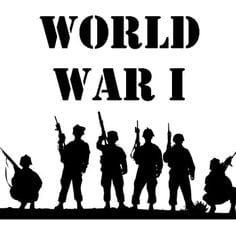
As always, we followed the project path throughout the course of the project;

Before we get into it, I shall explain a bit about the project itself; So, as I mentioned in the beginning, we will be creating a comic book focusing on WW1. The book was centred around one main event and had to include a story following a storyspine, comic vocabulary/tips, and fictionalized characters. The goal of this was to have each of us understand our topic enough to be able to creatively communicate and express our understandings in a modern and in my opinion, much more fun way than taking a test. If you think this all sounds familiar, that’s because we also created a comic book about cells and diseases last year in PLP 8. Because of this, we were also considerably more comfortable with using the app Comic Life 3 to develop our comics rather than in other projects where we are fully starting from scratch. Anyways, without further a due, let’s get into it!
So, to start off, we needed to build some knowledge! The first half of this project was spent ensuring we were experts on WW1. As for most of our history-based projects, we will be focussing on “Cause and Consequence”, specifically, our competency Analyzing Cause and Consequence. We will be looking at this competency throughout the project, but this was the first time we were able to practice this skill. Our first activity was learning about the four main causes of WW1: Nationalism, Imperialism, Alliances, and Militarism. To do this, we spent time reading about them through a textbook. After reading, we completed this worksheet:

And, after we completed that, we also wrote a reflection about what we believed the most significant cause of the war was because, as any PLP student knows “you only learn through reflection” – as Ms. Willemse says every time it’s blog post season. I feel that I represented a sophisticated level of understanding our competency “Analyzing Cause and Consequence” in this assignment. I did well at researching and developing a deep understanding of my topic to analyze the most significant cause of the war and express my analysis in a thoughtful and well written paragraph.
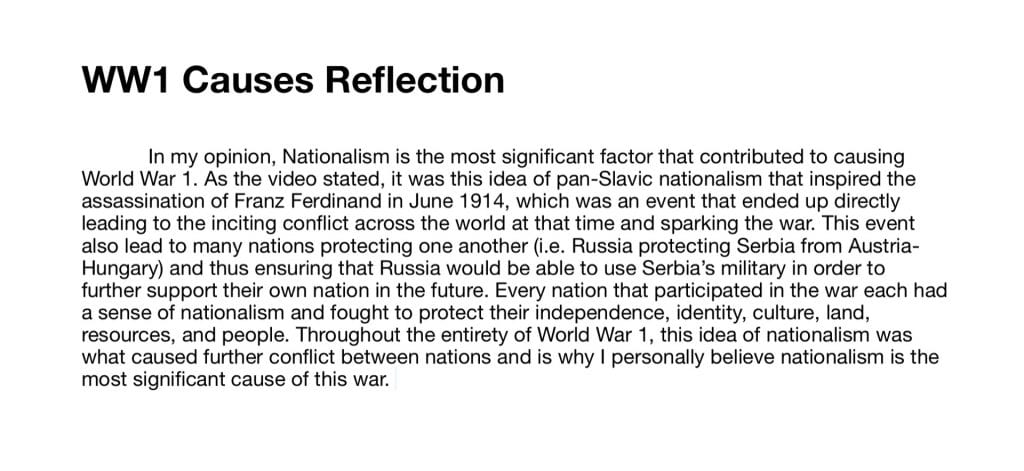
Next up propaganda! That’s right, time to learn about how they would use all sorts of questionable tactics to recruit young men to fight in the war. To learn about this, we read and looked at many examples of WW1 propaganda and finished off with a submission of an analysis worksheet in which we picked one example of WW1 propaganda and applied the knowledge we gained about propaganda to our specific example.
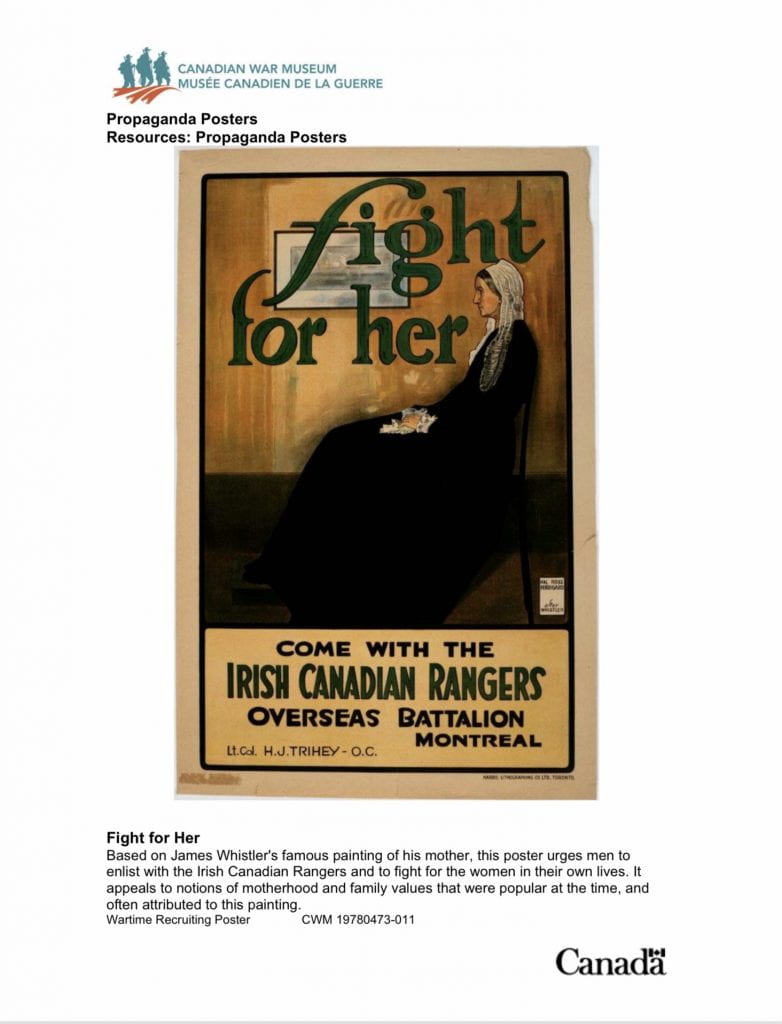

It’s Comic time! – just kidding, I mean, not really but sort of – anyways, to learn more about the history of World War One on the surface level, we read “The War to End All Wars” by Alan Cowsill. We read this graphic novel over a series of about four classes and annotated and took notes along the way. Although I am not a huge fan of Graphic Novels, I really enjoyed reading this book! The art was amazing, and I thought they did a great job at educating about real facts in a compelling way. I loved this book, because I honestly learned a lot from it! To solidify the knowledge we gained, we also completed a “3-21 Strategy Chart”:
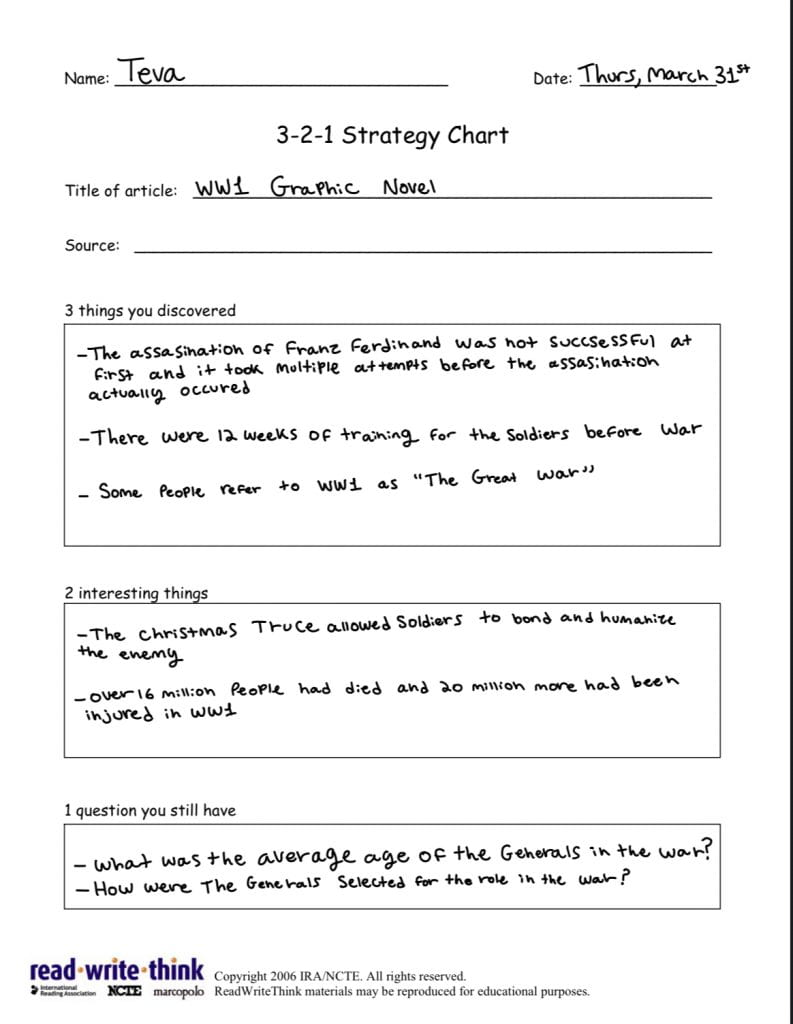
After we were finished reading the Graphic Novel, we submitted yet another reflection! In this one, we chose one specific battle to research and highlighting specific material from World War One: 1914-1918. We also had to discuss one immediate and one long term consequence of “the war to end all wars.” Further to the use of our mentor text within our response, we also had to reference our Social Studies textbook. I actually really enjoyed this reflection: I found it really interesting to fixate and deep dive one specific battle that we had touched on in the book!

It was at this point that things started getting really interesting! After building some knowledge, we, as a class, watched “1917”. This was an AMAZING film. I have to say, you know it’s a good movie when Teva cries- actually I take that back, movies make me cry all the time. How much I cried does not really dictate how truly breathtaking this film was. The cinematography, acting, set, everything was beautifully put together to create a masterpiece that is this film. This activity was a great way of learning about this topic in an engaging way.

Just before we started building the comic, we still needed to learn about comics. We learned about the different techniques, terminologies, and tips we would be using to create our own comics! And, once we had learned that, it was actually Comic time! After learning about comics, our first step is choosing our topic. Topic choice was first come first serve, and, unfortunately I was not in class the day that we chose topics so I ended up having limited options. That said though, I ended up choosing a topic that found really interesting! I chose “Canada’s One Hundred Days” which is a fairly broad topic covering the last one hundred days of the war.
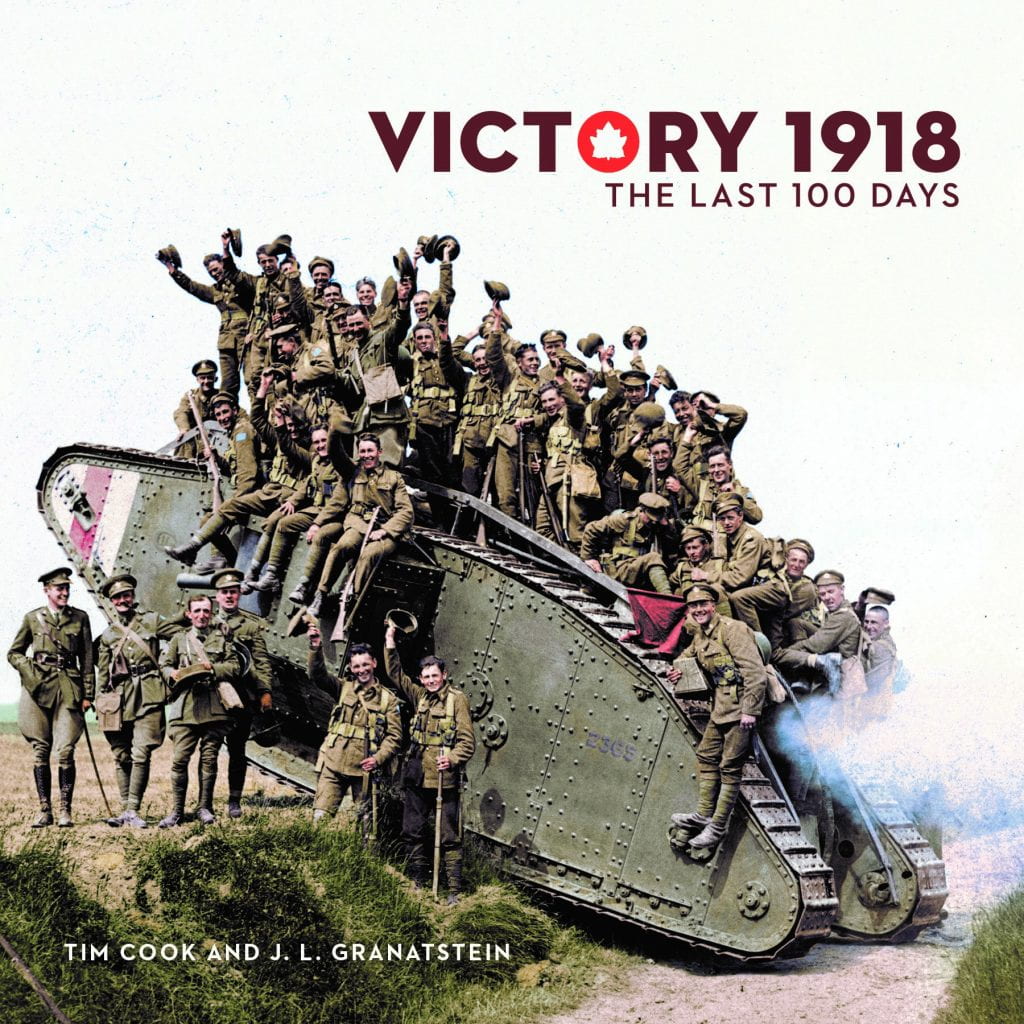
After choosing our topic, we needed to prepare to create our comic. We did this in three parts: 1: Research, 2: Establish a Story, 3: Plan. Each of these parts were all gathered together in our “Planning Documents”. For the first part, in order to gain a deep understanding of our topic, we did our own research and filled out the 5 W’s (Who, What, Where, When, Why) within our planning document.
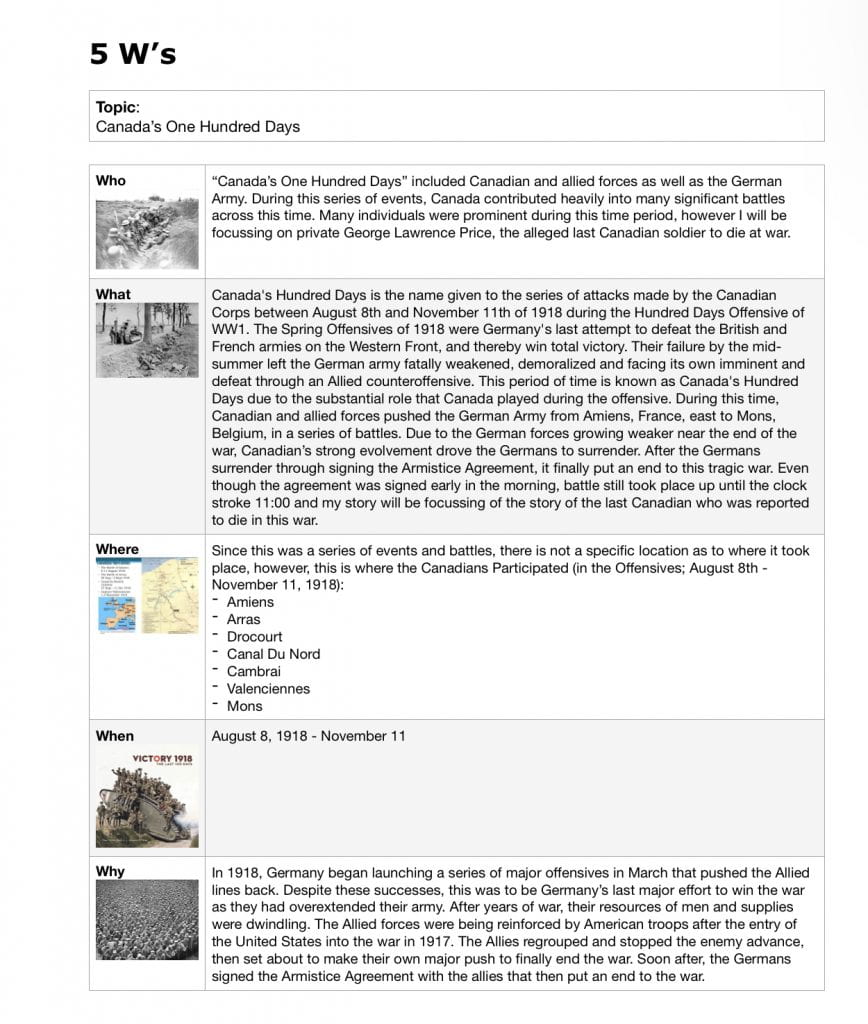
Next, developing the story. In our comic book, we needed at least two fictionalized characters. These characters could be based on real people, but we still had to add our own creativity. I knew that since my topic was so broad, I needed to choose an individual that was there for an eventful time period so that I am able to intertwine facts with my panels. So, I decided to choose the last Canadian soldier to die at war: George Lawrence Price. Feel free to read my Story Spine:

Now, for planning! In our document we also filled in a Story Board to plan for each of our panels within our comic. I found this part pretty challenging, since I had to visually represent my story in a concise and compelling way, which, is not really my strong suit. Regardless, I still enjoyed making my story board!

If you would like to view the full version of my Planning Documents, click here ⬇️
‘Tis finally time to make our comic! I won’t go into too much depth here, since most of the process was covered in my planning documents but I the process was basically just: pick template, draw out each panel, and create and fill each speech bubble and narratory block. Here, I feel that I did well at showcasing an accomplished understanding of the competency “Create Effectively” through using various apps and previous knowledge to create my comics
Here are some of the drawings I included in my comic:
Here are each of my Comic Book drafts!
[metagallery id=2035]
In class we were also able to get peer feedback to improve our comic! Ben gave me helpful feedback that helped me to improve my comic until it became it’s final form!

🌲Overall, I am really proud of myself. I know for a fact I did not demonstrate my best work in this project or met my standards much, but, I really made an effort to preserve my mental health. I didn’t overwork myself, and was really trying hard to minimize my workload. I still have a lot of time to improve my balancing act of school and personal life, but this project was a great opportunity to learn and grow from! I am happy with my ability to be aware of I am feeling, and I feel that that is more important that I practice taking care of myself than any project could be. That said, although I didn’t necessarily meet my standards, I am also happy with the understanding that I have gained. Am I happy with my comic? Not really. But, I still learned a lot from this project regardless, and I am extremely happy with the knowledge I have gained. So, how might we use graphic novels to understand Canada’s involvement in WW1? Well, we can create our very own novels filled with real facts with intent to educate others on Canada’s involvement in the war in a concise and creative way. I enjoyed this project, and as always, I hope you enjoyed watching me grow in the forest of 🌲
🌲learning🌲




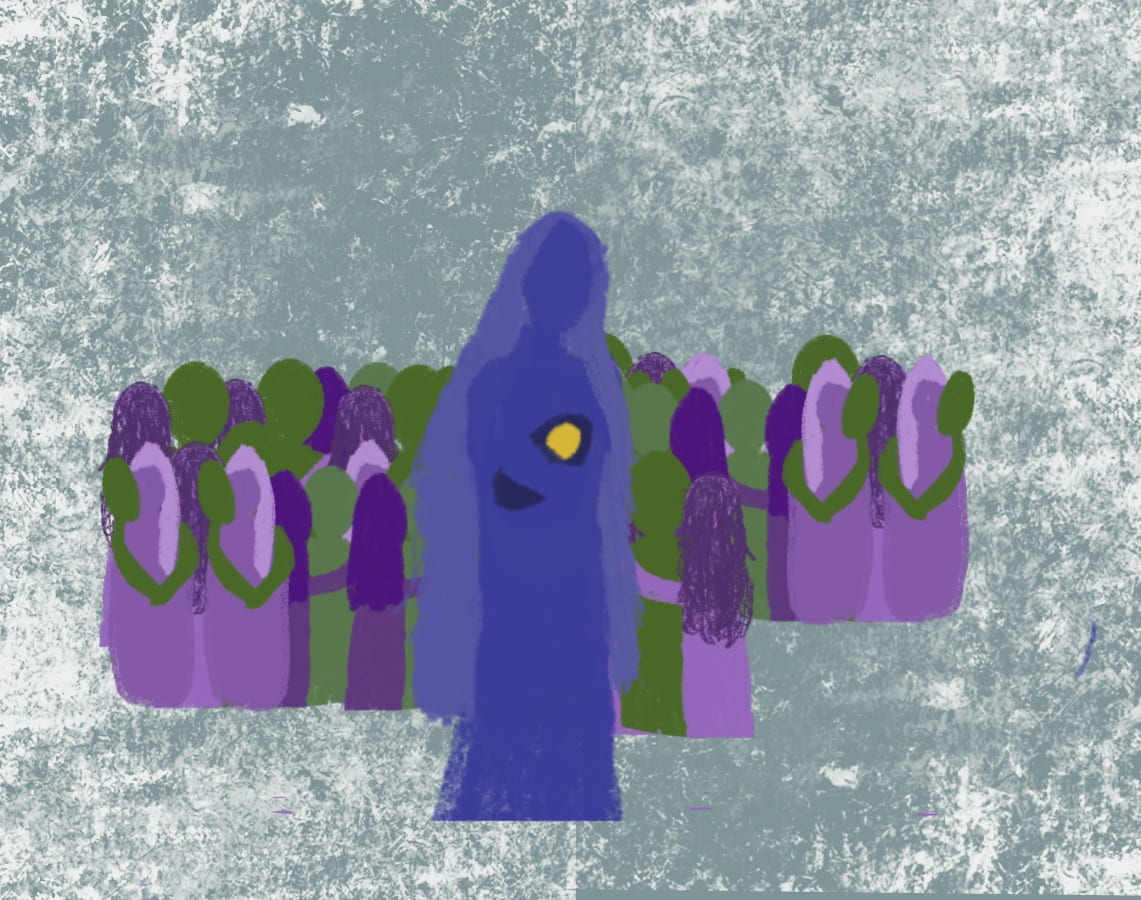



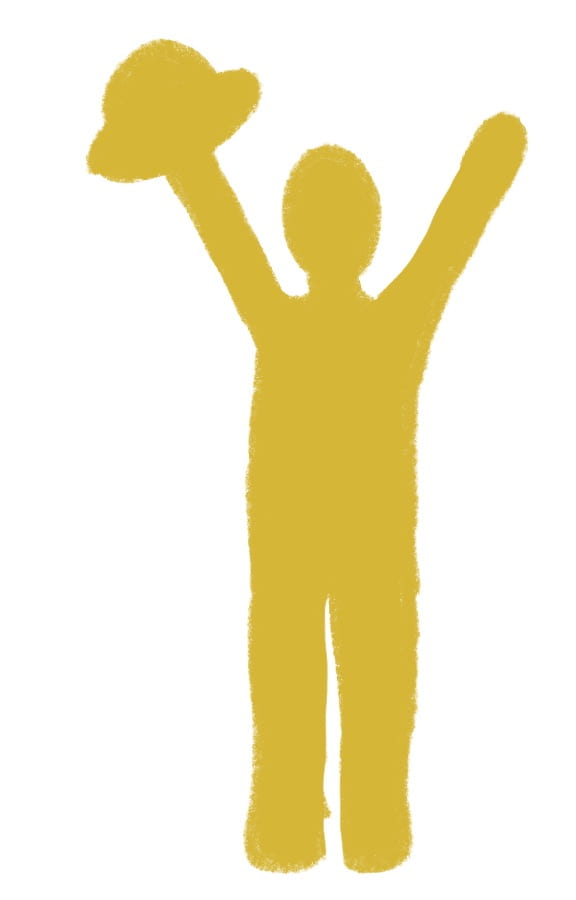
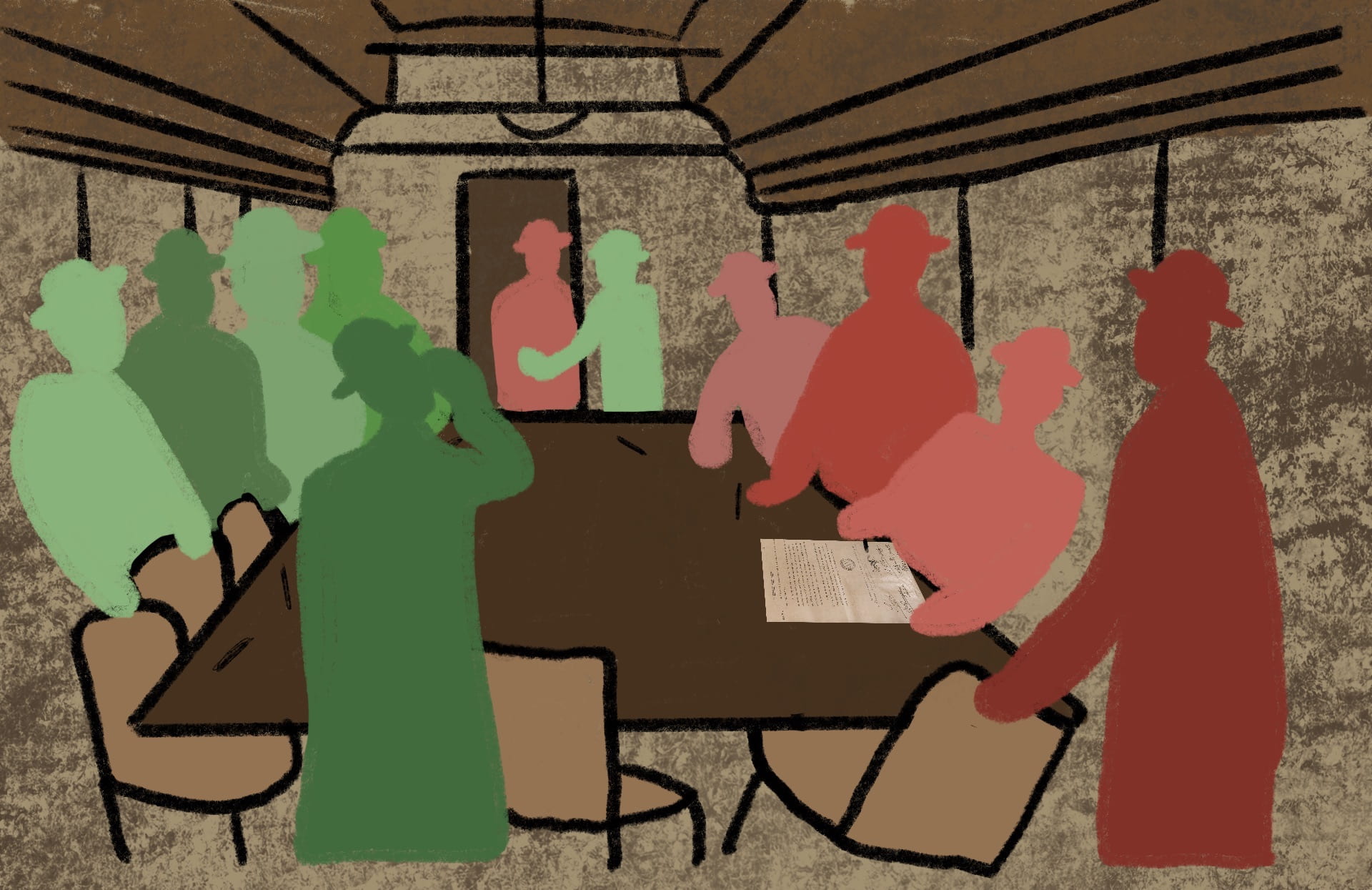
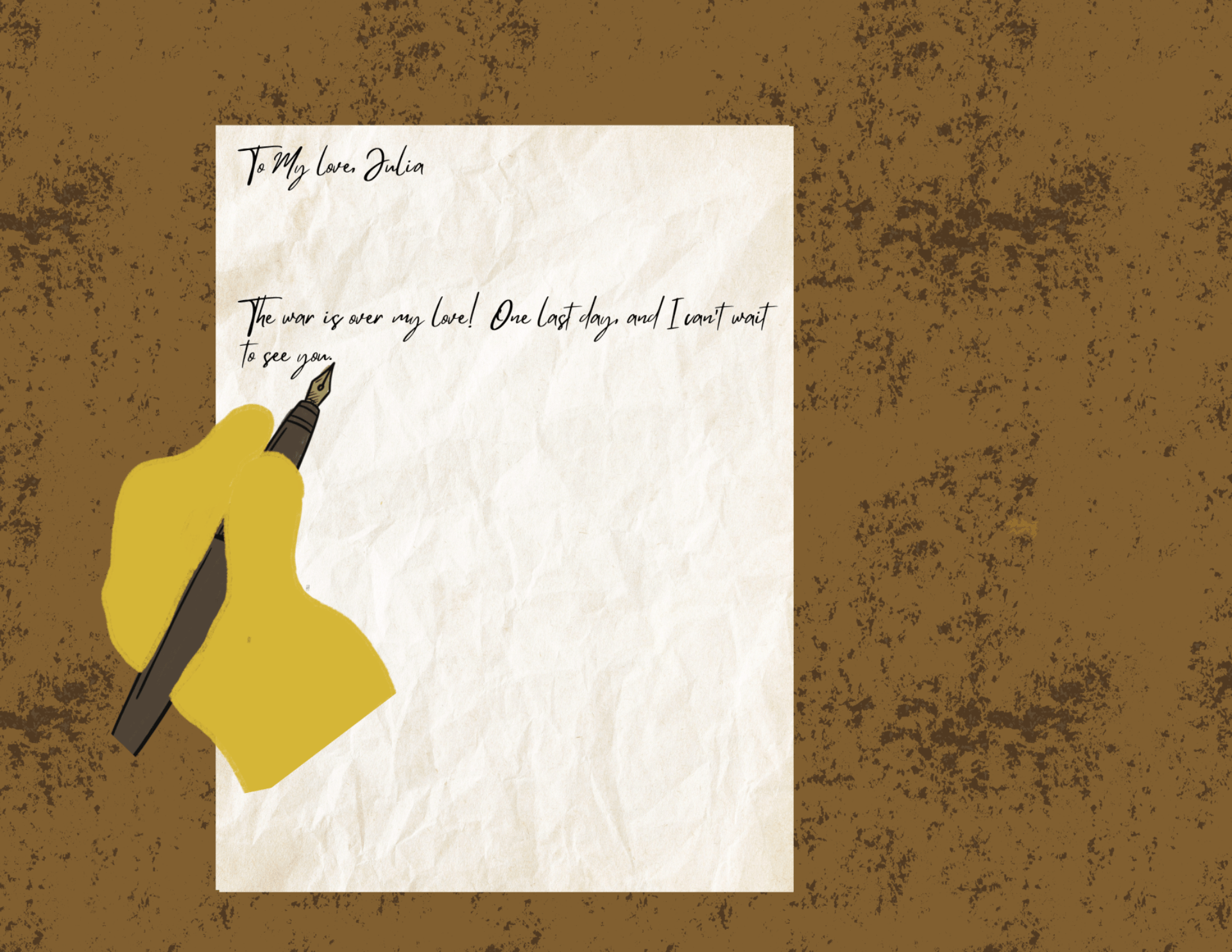

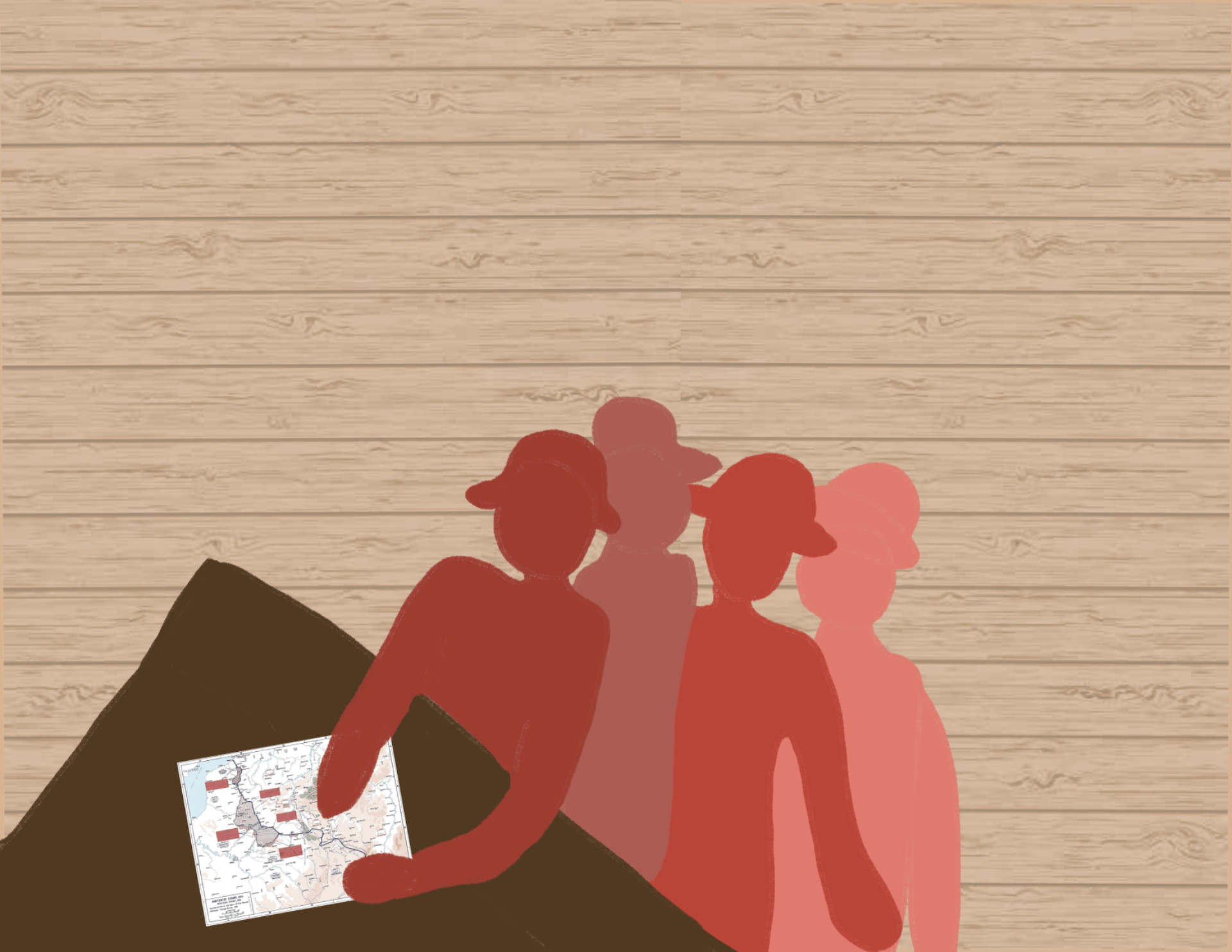

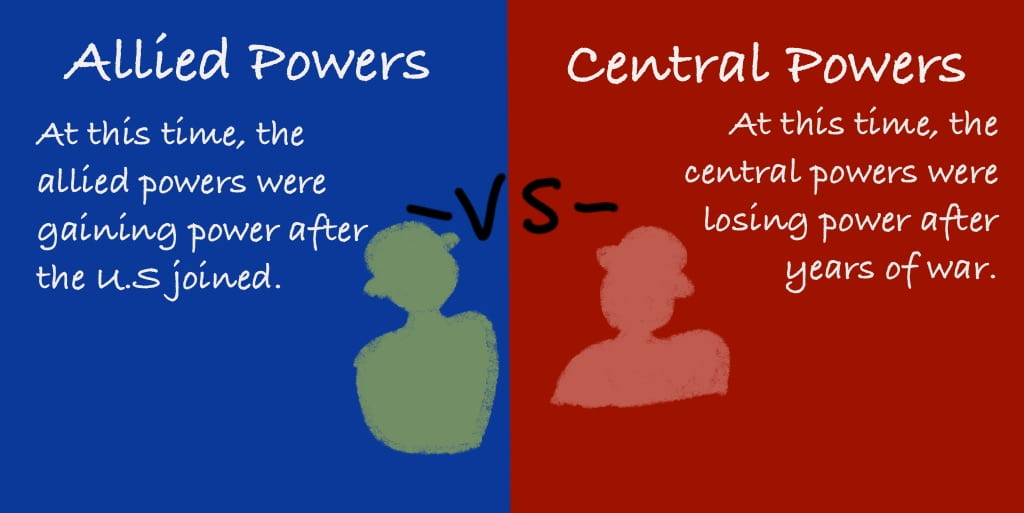
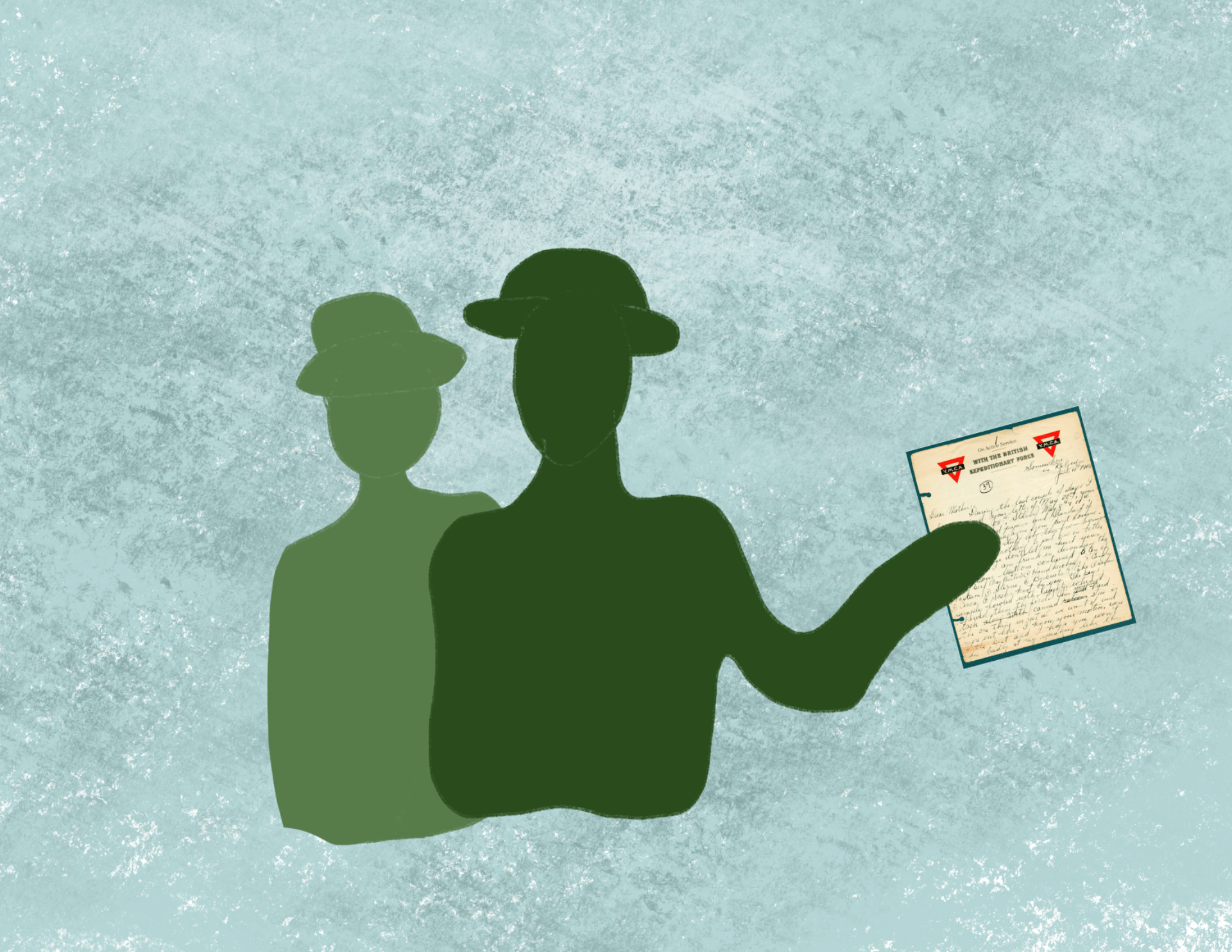
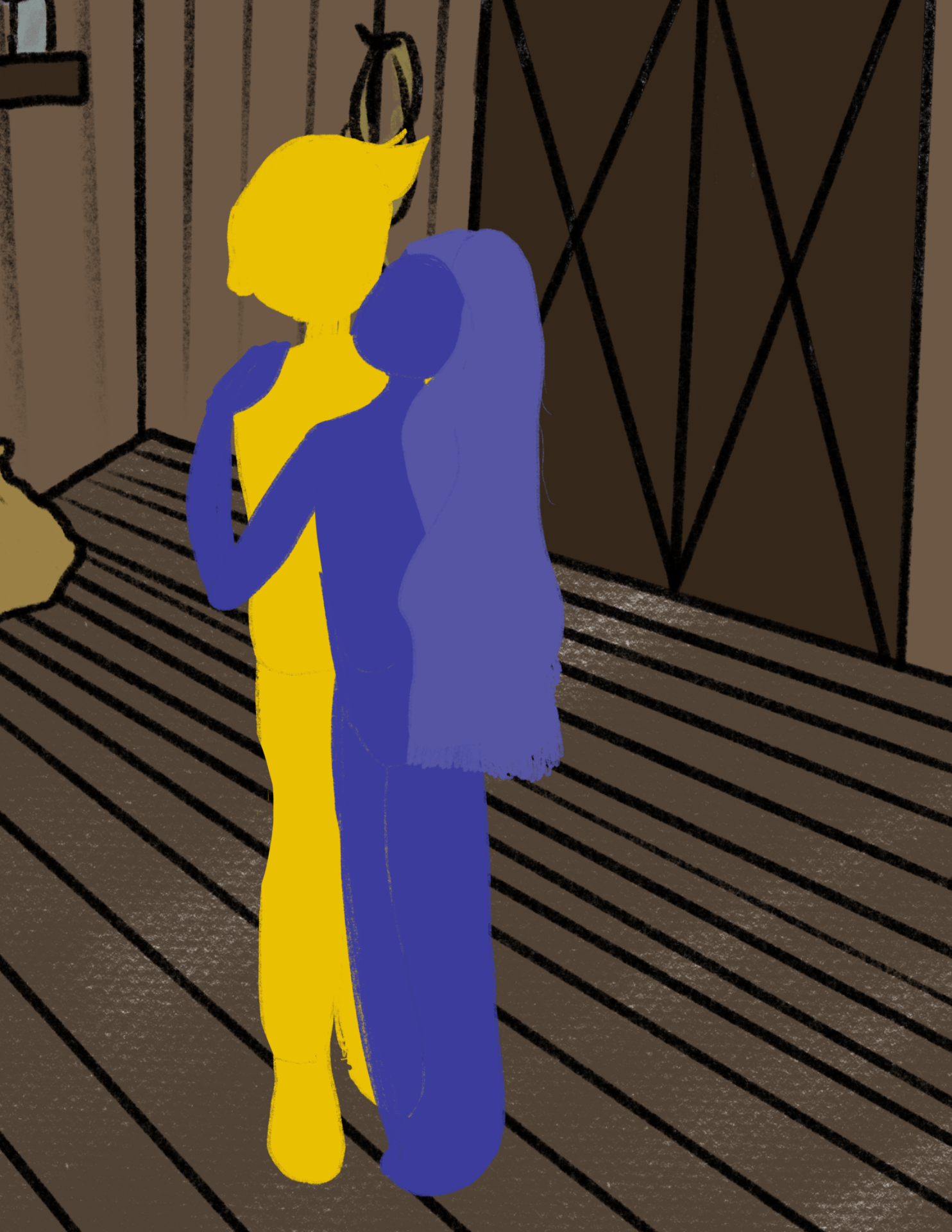

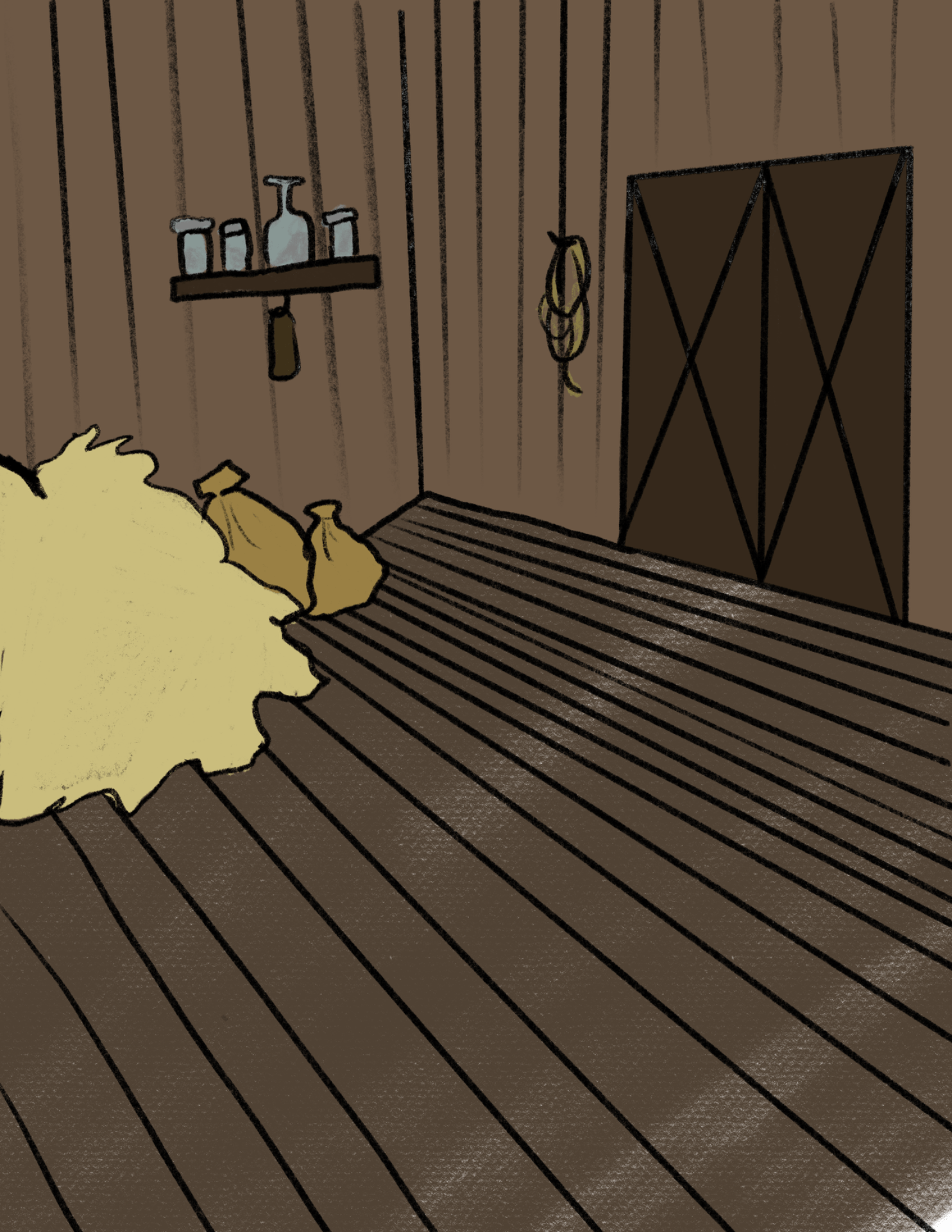



















Leave a Reply